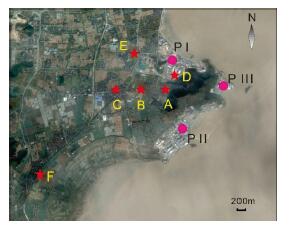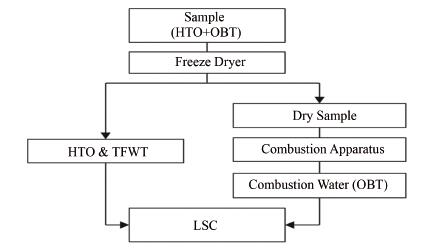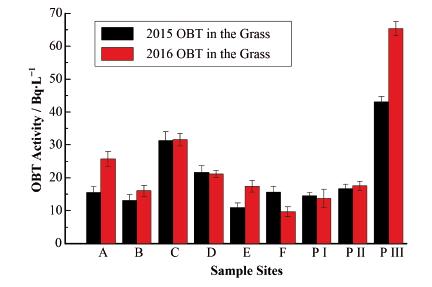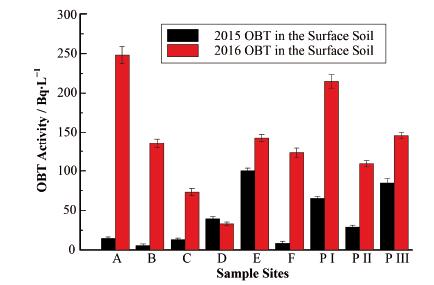2. 中国科学院大学 北京 100049
2. University of Chinese Academy of Sciences, Beijing 100049, China
氚(T)是氢唯一的放射性同位素,核电站的排放已成为它的主要来源[1]。核设施排放的氚主要以氚化水(HTO)、氚化氢(HT)以及少量的氚化甲烷(CH3T)形式存在[2−4],HT在进入土壤时在土壤微生物的作用下氧化成HTO[5],而土壤和大气中的HTO被植物根系和叶片吸收,成为植物体内的组织自由水氚(Tissue Free Water Tritium, TFWT)[6],TFWT在植物的光合作用下形成有机氚(Organically Bound Tritium, OBT)。土壤中的部分HTO可能转变成OBT,同时植物中的OBT也可能转变成土壤中的OBT。TFWT的含量可以表示核设施氚的排放的短期效果,而OBT的含量则可以表示核设施氚排放的长期累积效果[7]。故而准确测量核设施周围环境草地中的TFWT和OBT的含量与分布情况,可以判断出核设施的氚排放对周围环境的影响。
目前国内外的一些学者针对核设施周围的可食用植物中不同形态氚进行了一些测量与研究[8−10],以此确定核设施排放对人体是否有危害。但是因为农作物在灌溉、维护等过程中受到人为的干扰因素很大,所以对自然生长的、不受人为影响的野草进行分析更能表现出核设施的真正排放情况。本研究对秦山核电站周围环境中的一年生草及其所在表层土壤(0~2 cm)中的TFWT和OBT活度进行分析,以期得到秦山核电排放的氚对周围环境的影响。
1 材料和方法 1.1 采样情况秦山核电基地位于浙江省海盐县杭州湾北岸的秦山山麓。其中分布着秦山一期核电厂、二期核电厂、三期核电厂和一期扩建项目方家山核电厂。其中秦山三期核电厂是我国目前唯一的一座重水堆核电厂,重水堆在运行时会比其他类型的反应堆释放更多的氚[11],所以,秦山核电基地是我国研究核设施排放的氚对环境影响的理想地点。
秦山核电基地东面和南面朝海,一年中3~8月份偏东风较多,9~2月份以偏北风为主,7月份除东风外还会有较强的偏南风,故受核电站排放物影响的地区主要为核电厂西部地区和北部地区[12]。按照这一原则,采样点的选取如图 1所示,秦山一期核电厂和方家山核电厂相距较近,合并为一个点P Ⅰ。P Ⅱ和P Ⅲ分别是秦山二期和三期核电厂,A、B、C位于秦山三期核电厂的西部,D和E位于秦山三期核电厂的西北部,F位于核电基地的西南部。

|
图 1 采样点设置 Figure 1 Sampling sites |
2015年11月初和2016年11月初,在每个采样点处选取约2 m×2 m的同一块野生草地进行采样,每块草地选取5个点采样后混合,表层土壤使用小铁锹收集,同时去掉其中明显的草根等杂质。所有采样点采集的草为同一类型常见的一年生野草,草和土壤采集后迅速用不透光的铝箔密封袋密封保存,在实验室中储存于−18 ℃的冰柜防止水分的流失和植物的腐败。在两次采样前都没有明显的降雨发生。
1.2 不同形态氚的测量植物和土壤样品中不同形态氚的测量主要流程如图 2所示。实验使用冻干机抽取土壤样品中的HTO和草中的TFWT,剩余的干样烘干后放入自行设计的有机氚氧化燃烧炉[13]中进行燃烧。将得到的HTO、TFWT及燃烧水与闪烁液(Ultima Gold LLT)混合后置于液体闪烁计数器(Aloka, LB7)中测量。

|
图 2 样品中不同形态氚测量流程图 Figure 2 Measurement flow chart of different forms of tritium in the sample |
本实验中,每个采样点处的样品进行三次独立的实验,液闪的测量时间为1000 min,探测下限为1.32 Bq∙L−1。实验误差主要来自于液闪的测量误差。
2 结果与分析 2.1 草中TFWT和表层土壤中HTO如图 3所示,除了核电厂厂区内的三个采样点P Ⅰ、P Ⅱ和P Ⅲ之外,2015~2016年秦山核电基地周围草中TFWT活度范围在1.48~33.22 Bq∙L−1,表层土壤中HTO活度范围为0.52~85.09 Bq∙L−1。同样的实验也有报道,加拿大研究者对加拿大的核电站周围的农作物和动物草料以及20 cm深的土壤中的TFWT和HTO进行了测定[10],草中的TFWT活度范围为3.5~37.5 Bq∙L−1,土壤中HTO的活度范围为1.3~122.0 Bq∙L−1,基本与本实验得到的活度范围相同,说明秦山核电站排放的氚与加拿大核电站的排放在同一水平。

|
图 3 草中TFWT和表层土壤中HTO在核电基地周围的分布情况 (a) 2015年,(b) 2016年 Figure 3 Distribution of TFWT in the grass and HTO in the surface soil around Qinshan nuclear power station (a) 2015, (b) 2016 |
通过图 3连续两年的实验数据可以看出,表层土壤中HTO活度要高于草中TFWT的活度。草中TFWT的形成主要有两种途径:植物叶片上的小孔对空气中HTO的吸收和根系对土壤中的HTO的吸收[14]。正常情况下,植物中的TFWT会通过气孔以及根系和空气和土壤保持一种动态的变化关系,使植物中的TFWT的活度取决于空气和土壤水中的HTO活度。土壤中HTO的活度比草中TFWT高,说明草中TFWT大部分是来自根系从土壤中吸收的HTO。
通过图 1中各采样点位置可以看出,对于核电站主风方向上的西部地区(A、B、C)和西北部地区(D、E),草中的TFWT的活度和表层土壤中的HTO的活度都随着与核电站距离的增加而减小。西南部地区的采样点F处的草中TFWT和表层土壤中HTO的活度都处于一个较低的活度。这与污染物在大气中的扩散规律相一致,证实了在主风方向地区受核电站排放影响几率较高的预测[12]。土壤中HTO和草中的TFWT在空间上的分布也与很多实验[7−8, 10]的结果类似,距离核设施和氚排放点越远的采样点,其中的HTO和TFWT活度也越低。因为草和土壤中的HTO与空气中的HTO交换速率较快,故而对于核电站周围环境中草地的HTO监测可以较好地反应出核设施的短期排放对环境的影响。
2.2 草和表层土壤中OBT如图 4所示,草中OBT在2015~2016年的监测中同一采样点活度变化不大。植物合成的OBT具有累积效应,在本研究中采集的草为一年生草,所以两年草中OBT活度变化不大可以表明在监测的这两年中,秦山核电基地的氚年均排放量应该变化不大。根据国家核安全局2015年和2016年年报[15−16]显示,采样的两年里,秦山核电基地没有异常排放,故在采样的两年,秦山核电基地排放量应当在同一水平。所以,通过测量核设施周围环境中一年生的植物中的OBT可以判断核设施的氚排放对周围环境的累积影响。

|
图 4 草中OBT在核电基地周围的分布情况 Figure 4 Distribution of OBT in the grass around Qinshan nuclear power station |
在与秦山三期相同堆型(CANDU-6)的加拿大Gentilly-2核电站周围1.5 km处的动物草料OBT测量实验[10]中,除了一个最高值193 Bq∙L−1,其活度范围为14.1~21.6 Bq∙L−1,与本实验中与秦山三期相同距离点A、B、D点测量的活度范围(13.03~ 21.63Bq∙L−1)一致。这也表明了秦山核电站的排放和国际同类核电站的氚排放量在同一水平。
对于采样点处的表层土壤,其OBT的分布情况如图 5所示。土壤中OBT的分布显示出其存在空间分布,但分布规律与图 4中草的分布不同,主要原因是因为表层土壤中OBT的形成受多种因素的影响。表层土壤和草中OBT形成机制不相同,表层土壤中OBT来源于微生物对表层落叶、动植物残体的分解和对HTO的转化等途径,而植物中的OBT主要是通过光合作用合成,不同的合成方式会导致最终的分布情况不同。

|
图 5 表层土壤中OBT在核电基地周围的分布情况 Figure 5 Distribution of OBT in the surface soil around Qinshan nuclear power station |
通过对比图 4和图 5,除了2015年B、C、F点外,其余各采样点处表层土壤OBT活度大于同一采样点草中OBT活度。这是因为土壤中OBT有常年累积的作用,而本实验中的草为一年生的草,累积量没有土壤多,所以土壤中的OBT总体上比草中OBT活度要高。
2.3 草和表层土壤中TFWT (HTO)与OBT的关系目前,为了探究不同环境介质中OBT的形成,国外学者主要使用OBT/TFWT (HTO)的值来表示二者关系。从表 1中可以看出,对于草和表层土壤中OBT/TFWT (HTO)的比值,本实验中其范围为0.69~10.59(2015年草)、0.48~4.99(2016年草)、0.45~16.27(2015年表层土壤)、0.93~10.98(2016年表层土壤),平均值为3.15(2015年草)、1.84(2016年草)、4.40(2015年表层土壤)、4.97(2016年表层土壤)。这与国外研究者分析的核设施周围的植物、土壤中比值在同一范围内,且都是草中的比值要小于土壤中的比值[7, 10, 17−18]。但目前加拿大标准认为,环境样品中OBT/HTO的值应该在0.64~1.30,平均值为0.70[19],这显然比目前实验值要小。因为目前的草和表层土壤中OBT/TFWT (HTO)的比值都要比给定值要大,这也说明了OBT是与有机物结合的,比水更不易被分解掉,具有累积效果。同时,土壤中比值比草中比值大,说明OBT的形成机制会因为介质的不同而有所差别,土壤中OBT的来源比草要复杂,不仅来源于HTO,还可能来自于其他途径,如土壤中微生物的分解作用,动植物残骸等。
| 表 1 草和表层土壤中OBT/TFWT比值 Table 1 The ratios of OBT/TFWT in the grass and the surface soil |
本文通过对秦山核电基地周围草地中的草和表层土壤进行分析,得到以下几个结论:
1) 草中TFWT和表层土壤中HTO的活度在采样地区主风方向,即西方和西北方上距离核设施越远越小;
2) 草中OBT在同一采样点上2015年与2016年的活度变化不大,说明在采样的两年里,秦山核电基地年累积排放氚的量处于同一水平;
3) 表层土壤中的OBT分布与草中OBT分布不一致,且活度大体上比草中OBT要高,表明土壤中OBT有多年累积的效应;
4) 草的OBT/TFWT比值为0.48~10.59,平均值2.50,表层土壤的相应值为0.39~16.27,平均值4.69。草的OBT/TFWT比值明显小于表层土壤的相应值,表明表层土壤中OBT的来源比草要复杂,可能不仅是来源于HTO,还来源于其他途径,如土壤有机质等。
致谢 特别感谢中核核电运行管理有限公司环境检测实验室的相关人员对于本实验采样的指导。| [1] |
NCRP 62. Tritium in the environment: recommendations of the national council on radiation protection and measurements[M]. Washington, DC: National Council on Radiation Protection and Measurements, 1979: 8-21.
|
| [2] |
Eyrolle F, Ducros L, Le Dizès S, et al. An updated review on tritium in the environment[J]. Journal of Environmental Radioactivity, 2018, 181: 128-137. DOI:10.1016/j.jenvrad.2017.11.001 |
| [3] |
Qin L, Xia Z, Gu S, et al. A novel atmospheric tritium sampling system[J]. Nuclear Instruments and Methods in Physics Research Section A:Accelerators, Spectrometers, Detectors and Associated Equipment, 2018, 892: 127-133. |
| [4] |
Baglan N, Kim S B, Cossonnet C, et al. Organically bound tritium (OBT) behaviour and analysis:outcomes of the seminar held in Balaruc-les-Bains in May 2012[J]. Radioprotection, 2013, 48(1): 127-144. DOI:10.1051/radiopro/2012051 |
| [5] |
王斐, 刘卫, 唐景春. 土壤微生物氧化氢及其同位素的研究进展[J]. 核技术, 2011, 34(2): 143-146. WANG Fei, LIU Wei, TANG Jingchun. Progresses in microbial oxidation of hydrogen and its isotopes in soil[J]. Nuclear Techniques, 2011, 34(2): 143-146. |
| [6] |
Boyer C, Vichot L, Fromm M, et al. Tritium in plants:a review of current knowledge[J]. Environmental and Experimental Botany, 2009, 67(1): 34-51. DOI:10.1016/j.envexpbot.2009.06.008 |
| [7] |
Kim S B, Bredlaw M, Korolevych V Y. HTO and OBT activity concentrations in soil at the historical atmospheric HT release site (Chalk River Laboratories)[J]. Journal of Environmental Radioactivity, 2012, 103(1): 34-40. |
| [8] |
Vichot L, Boyer C, Boissieux T, et al. Organically bound tritium (OBT) for various plants in the vicinity of a continuous atmospheric tritium release[J]. Journal of Environmental Radioactivity, 2008, 99(10): 1636-1643. DOI:10.1016/j.jenvrad.2008.05.004 |
| [9] |
Vagner I, Varlam C, Faurescu I, et al. Organically bound tritium level in vegetation at ICIT tritium removal facility[J]. Journal of Radioanalytical and Nuclear Chemistry, 2015, 303(3): 2559-2563. DOI:10.1007/s10967-014-3791-9 |
| [10] |
Thompson P A, Kwamena N-O A, Ilin M, et al. Levels of tritium in soils and vegetation near Canadian nuclear facilities releasing tritium to the atmosphere:implications for environmental models[J]. Journal of Environmental Radioactivity, 2015, 140: 105-113. DOI:10.1016/j.jenvrad.2014.11.009 |
| [11] |
Melintescu A, Galeriu D. Uncertainty of current understanding regarding OBT formation in plants[J]. Journal of Environmental Radioactivity, 2017, 167: 134-149. DOI:10.1016/j.jenvrad.2016.11.026 |
| [12] |
王伟平, 余锡刚. 秦山核电厂地区风场特征[J]. 浙江气象科技, 1994, 15(2): 27-32. WANG Weiping, YU Xigang. Characteristics of wind field in Qinshan Nuclear Power Plant[J]. Zhejiang Meteorological Science and Technology, 1994, 15(2): 27-32. |
| [13] |
Du L, Shan J, Ma Y H, et al. An improved combustion apparatus for the determination of organically bound tritium in environmental samples[J]. Applied Radiation and Isotopes, 2016, 110: 218-223. DOI:10.1016/j.apradiso.2015.12.031 |
| [14] |
方栋, 李红. 环境中氚和碳-14[J]. 辐射防护, 2002, 22(1): 51-56. FANG Dong, LI Hong. Tritium and carbon-14 in the envrionment[J]. Radiation Protection, 2002, 22(1): 51-56. DOI:10.3321/j.issn:1000-8187.2002.01.009 |
| [15] |
国家核安全局2015年年报[EB/OL]. http://nnsa.mee.gov.cn/zhxx_8953/haqnb/201608/P020160803523361389292.pdf, 2015. Annual report of National Nuclear Safety Administration in 2015[EB/OL]. http://nnsa.mee.gov.cn/zhxx_8953/haqnb/201608/P020160803523361389292.pdf, 2015. |
| [16] |
国家核安全局2016年年报[EB/OL]. http://nnsa.mee.gov.cn/zhxx_8953/haqnb/201707/P020170712499760277634.pdf, 2016. Annual report of National Nuclear Safety Administration in 2016[EB/OL]. http://nnsa.mee.gov.cn/zhxx_8953/haqnb/201707/P020170712499760277634.pdf, 2016. |
| [17] |
Kim S B, Workman W G, Korolevych V, et al. Field measurements of key parameters associated with nocturnal OBT formation in vegetables grown under Canadian conditions[J]. Journal of Environmental Radioactivity, 2012, 104(1): 94-100. |
| [18] |
Korolevych V Y, Kim S B, Davis P A. OBT/HTO ratio in agricultural produce subject to routine atmospheric releases of tritium[J]. Journal of Environmental Radioactivity, 2014, 129: 157-168. DOI:10.1016/j.jenvrad.2013.12.014 |
| [19] |
N288. 1-14: Guidelines for calculating derived release limits for radioactive materials in airborne and liquid effluents for normal operation of nuclear facilities[S]. Canada: Canadian Standards Association, 2017.
|


